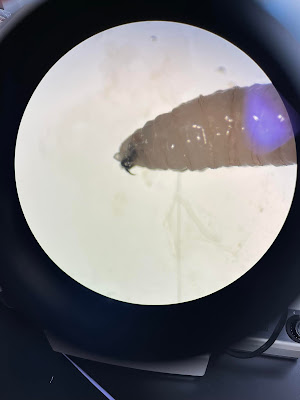Answer to Parasite Case of the Week 691: Fly larva, consistent with Lucilia species, (or as Florida Fan noted, "I love Lucy!")
There are numerous keys for identifying fly larvae, including the freely-available CDC pictorial keys (https://www.cdc.gov/nceh/ehs/publications/pictorial_keys.htm) and a simplified key that Blaine and I published in our review on Laboratory Identification of Arthropod Ectoparasites (Clinical Microbiology Reviews). These keys are very easy to use once one is familiar with the basic morphologic parts of fly larvae (e.g., spiracular plates, mandible).
Identification to the species level is based on several features including the general body characteristics, arrangement of cuticular spines, mouthparts, and the posterior spiracles. In this case, Dr. Brammer Hubbard was able to get beautiful photographs of all of the key morphologic features so that we can easily make our identification. These show us that there is not an accessory oral sclerite on the mandible, the posterior spiracular slits are straight, and the spiracular plate and button are not heavily sclerotized. This leads us to a final identification of Lucilia species.
Lucilia is a cause of facultative wound myiasis rather than obligatory myiasis. If you are interested, you can read about it in the chapter that Blaine and I wrote on "Encyclopedia of Infection and Immunity: Parasites of the Ear." (Let me know if you'd like a copy 😊)

















